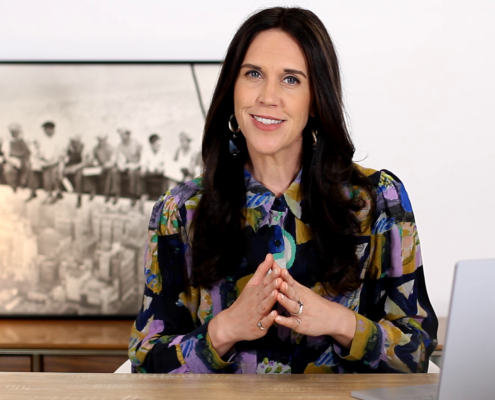EMPLOYEES TRUST THEIR EMPLOYER MORE THAN ANY OTHER INSTITUTION
Trust levels are at an all-time low, but there is one institution that is seeing an emergence of trust!
In the 2019 Edelman Trust Barometer (The Barometer), a trust and credibility survey, 75% of respondents said they trust “My Employer”; more than business in general (19 points) and more than government (27 points).
Now is the time for organisations to leverage this trust to further engage their employees and grow their business and in this video I give you some tips on how to do just that by leading from the heart.
(P.S. If you’re a reader, rather than a viewer, feel free to continue reading … and save the video for another time).
TRUST AS AN ECONOMIC DRIVER
The Barometer gets a lot of attention because it’s a great indicator of which institutions and individual roles in those institutions need to pick up their game; conversely, it’s also an opportunity for others to shine and leverage that trust as a strategic advantage.
As Stephen M.R. Covey has said, trust levels should not be mistaken as simply a soft, social virtue; rather, he suggests it is a ‘hard, economic driver for every organisation’. He suggests that “some of the consequences of low trust environments, are low morale, disengagement and a lack of commitment. You’ll also see people manipulating, distorting facts and withholding information. There will be resistance to new ideas, bad-mouthing, gossiping, finger-pointing, overpromising and under-delivering and, often, tension and fear. Everything will take longer to do, and everything will cost more.”
In a safety leadership context, if there are low trust levels it will limit your company’s traction in achieving its safety initiatives and implementing change, it will prevent the full implementation of your safety management system, and cloud your understanding of how well the business is doing at managing its health & safety risks because people won’t report incidents or issues because they don’t trust that anything will be done with that information.
This will all be exacerbated if you have low trust levels between the board and executive, because the executive will tell the board what they want them to hear, not what they should hear.
So as a director, here are three things you can do personally to build a foundation of trust and confidence with the people you work with.
1 – FOCUS ON YOUR CIRCLE OF INFLUENCE
I’ve put this one first for a reason. Because in order to do the next 2, you need to be aware of your ‘Circle of Influence’. That is, where you have the greatest impact.
If you start with building trust amongst your director peers and with the executive team you will have a greater chance of influencing trust throughout the organisation because people will take your lead.
The phrase, circle of influence, was coined by Covey and it means that people are working on the things they can do something about. He refers to these people as proactive people, where the nature of their energy is positive, enlarging magnifying causing their Circle of Influence to increase. Conversely, those who are reactive work in their Circle of Concern. They focus on circumstances of which they have no control. The negative energy generated by that focus, combined with neglect in areas they could be doing something about, causes their Circle of Influence to shrink.
So if you’re focusing on how to influence behaviour on the shop floor, you’re going to get a bit frustrated, and no doubt that’s not new to you … because it is frustrating as a director who is so many steps removed from day-to-day decision-making.
So that’s the first point, focus on what you can do personally in the boardroom to build trust and sooner or later that trust will expand into the rest of the business because your circle of influence will expand.
2- LEAD BY EXAMPLE
We can link this back to the Circle of Influence, because those who are proactive, lend themselves more to being leaders, rather than those who are reactive.
Leading from your heart in the boardroom and in general can be lonely, because heartfelt leadership is traditionally seen as a weakness.
But ‘nothing changes, if nothing changes’.
So if you want to influence trust in the boardroom amongst your peers, but particularly with the executive, you may need to step outside of the normal behaviour in your boardroom and lead by example.
For some of you, it may require creating new habits that demonstrate your trustworthiness and some of you may already be demonstrating these habits, just not in the boardroom.
So what are those habits…?
3- DEMONSTRATE ABILITY, BENEVOLENCE AND INTEGRITY (ABI)
Although these variables are not trust per se, research has suggested that they help build the
foundation for the development of trust.
Ability
So in terms of ‘ability’ – look to build your competence in leading safe & healthy work in the boardroom. That is, have a sound understanding of health & safety concepts, language, and the risks in your industry and business so that you know what to ask and when to act.
By doing so, you’ll increase your credibility with your peers and the executive and most definitely your safety manager as a result. This will give you the confidence and ability to ask more targeted questions and those tasked with responding will have greater trust in your ability to have a more valuable conversation that would likely open itself up to more insights and information that you may not have received or been privy to previously.
Benevolence
Now how can you demonstrate benevolence? Well, research suggests this looks like loyalty, openness, receptivity, and caring.
One way you can show your executive that you care, and I talked about this in a previous video and I’ll provide a link in the show description, but check in with your executive on how their mental health is going – again, work in your circle of influence.
And know that there have been a number of CEO suicides in the last 10 years due to stress, anxiety and depression – so this shouldn’t be a foreign concept to ask your CEO about their mental health.
Now you can also watch for signs of their physical health like fatigue or strains they’re experiencing because they are likely working long hours, sometimes that could be at home in a very awkward set up, and over time that’s going to show in their posture or other signs of pain that they may be experiencing.
The result we’re looking for here, is that the executive sees that you care enough to ask, and that signals to them that they can trust that you want to hear the answer. It will also give them the support to do the same with their team, and so on and so on it moves through the business – just by working within your circle of influence, you end up building employee trust for their manager.
Integrity
And finally, you want to be able to demonstrate integrity and that looks like being fair, reliable, consistent, delivering on your promises and being honest.
One way you can act with integrity is to actively and consistently prioritise safety and wellbeing to demonstrate it’s a priority to you or a non-negotiable.
For example, ask management to demonstrate that they have considered the safety implications from the strategic changes they’re requesting the boards approval on? Consistently asking management in this way will trigger them to consider these implications in the future when presenting proposals. Again, you are leading by example in your circle of influence, and the executive will take your queue that it’s a priority and that will influence how they behave going forward because they’ll make sure they’re prepared to give you this information in the future.
IN SUMMARY
For you to personally build a foundation of trust and confidence with the people you work with, start with where you have the most influence and that’s in the boardroom with your peers and the executive.
Know that heartfelt leadership may mean that you need to lead by example, but remember, nothing changes, if nothing changes.
And finally, demonstrate ability, integrity and benevolence by improving your skills, showing the executive you care and be consistent in demonstrating that safety is a priority.
QUESTIONS & ACTION
Now in light of today’s topic on leading from the heart, don’t forget that I have a quiz for you that will help you discover your personal Boardroom leadership style in less than 2 minutes where you’ll see whether your leadership style in the boardroom is well-aligned to leading from the heart. I’ve provided a link to the quiz in the description below this video.
And finally, if you found this topic interesting, check out this year’s Director Health & Safety Dashboard. It covers critical issues from 2018 such as the lowering of global trust levels, across business, government and regulatory landscapes that should be on every directors’ radar in 2019. Click HERE to get your copy.
One of the foundational principles of leading safe & healthy work is sharing knowledge – across business, industry and borders.
So in the context of sharing, let this community know in the comments below,
- What one thing resonated the most with you from this video? Or what are other tips you can give this audience for developing trust in the boardroom?
Leave a comment below and let me know.
Remember, share as much detail as possible in your reply. Your story and/or thoughts may lead to someone’s meaningful breakthrough and it all contributes to this audience knowing What to Ask, and When to Act #knowWTA
Important: share your thoughts and ideas directly in the comments. Links to other posts, videos, etc. will be removed.
Thank you so much for adding your perspective to the conversation.
Thanks for watching!
Welcome!
I’m Samantha
As a business leader, you have a responsibility to lead safe and healthy work whether that’s at an executive or board level. My job is to assist you in your role by giving you the tools and knowledge to know what to ask, and when to act.
RESOURCES
YOU MAY ALSO LIKE…
FEATURED CONTENT
[text-blocks id=”4249″ plain=”1″]








Let us know what you have to say:
Want to join the discussion?Your email address will not be published.